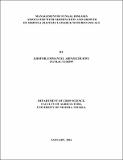UNNSpace Repository
Management of Fungal Diseases Associated with Germination and Growth of Moringa Oleifera Lamarck with Botanicals
JavaScript is disabled for your browser. Some features of this site may not work without it.
| dc.contributor.author | Ejiofor, Emmanuel Arinzechukwu
|
|
| dc.date.accessioned | 2017-04-24T10:54:33Z | |
| dc.date.available | 2017-04-24T10:54:33Z | |
| dc.date.issued | 2017-04-24 | |
| dc.identifier.uri | http://hdl.handle.net/123456789/4473 | |
| dc.description.abstract | Studies were carried out at the Department of Crop science, University of Nigeria Nsukka (UNN) to evaluate botanicals control of diseases associated with growth and germination of Moringa seeds. Five accessions of Moringa seeds collected from Imo, Enugu, Kogi, Plateau and Kaduna states of Nigeria were used. The following experiments were carried out: seed viability test, isolation of fungal pathogens, determination of phytochemicals, in vitro control of the pathogens with six botanicals, phytoxicity test of the botanicals on M. oleifera seeds and early growth study of the treated and untreated seeds. The viability test revealed significant (p < 0.05) differences in some of the germination traits of the five accessions of moringa seeds. Kaduna accession gave the highest number of days to first germination (approx. 6 days) followed by Jos and Imo with same value (approx. 4 days) and the lowest was Nsukka (approx. 3 days). The following organisms were isolated from the seed coats; namely, Aspergillius niger, A. flavus, A. glaucus, Fusarium oxysporium, Mucor spp, Cunnighamella spp, Penicillium digitatum. Only A. flavus was isolated from the cotyledon (seed without coat). The percentage disease incidence was highest in Kaduna (99.90%) on seed with coat and (89.75%) on seed without coat. Enugu accession had the lowest percentage disease incidence (10%) and (0%) for seed with coat and those without coat respectively. Aspergillius flavus had the highest percentage frequency of occurrence (16.31%) while the value for Fusaruim oxysporium and Mucor spp were lowest and statistically the same (0.27%). At both 50 and 70 grams/liter levels of concentration, Aspilia africana leaf extract showed the highest percentage growth inhibition for 14 days while the lowest was obtained in Cassia alata. Phytotoxicity test revealed that at 50 grams/liter O. gratissemum leaf extract significantly ( p < 0.05) gave the highest number of days to first germination (approx. 6 days) while A. africana leaf extracts gave the lowest (approx. 4 days). The main effects of Aspilia africana leaf extract treatment on plant height, stem girth, number of leaves, number of buds and number of nodes were significant (p , 0.05). The seedlings treated with Aspilia africana leaf extracts at 12 weeks after planting had higher plant height, stem girth, number of leaves, number of buds and number of nodes than the untreated. (Treated: 59.61, 3.21, 17.90, 4.51 and 18.18 cm) while the untreated gave lower values (untreated: 54.58, 3.19, 16.60, 4.27 and 15.89 cm) respectively. The duration of storage significantly (p < 0.05) affected the incidence of diseases on the fresh and stored Moringa oleifera leaf products. Two months of storage gave the highest percentage disease incidence (19.66%) which differed significantly (p < 0.05) from others. Zero storage (at harvest) gave the lowest value (0.92%). The result of the study shows that all the leaf extracts inhibited the growth of the fungal isolates but Aspilia africana leaf extract was more effective because it gave relatively less adverse effect to germination and growth of the Moringa oleifera seeds tested. | en_US |
| dc.language.iso | en | en_US |
| dc.subject | Fungal Diseases | en_US |
| dc.subject | Moringa Oleifera | en_US |
| dc.subject | Moringa Seeds | en_US |
| dc.title | Management of Fungal Diseases Associated with Germination and Growth of Moringa Oleifera Lamarck with Botanicals | en_US |
| dc.type | Thesis | en_US |
